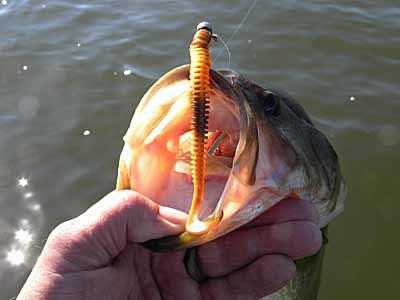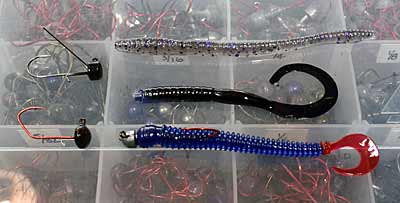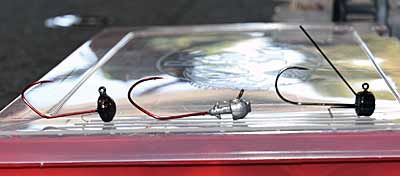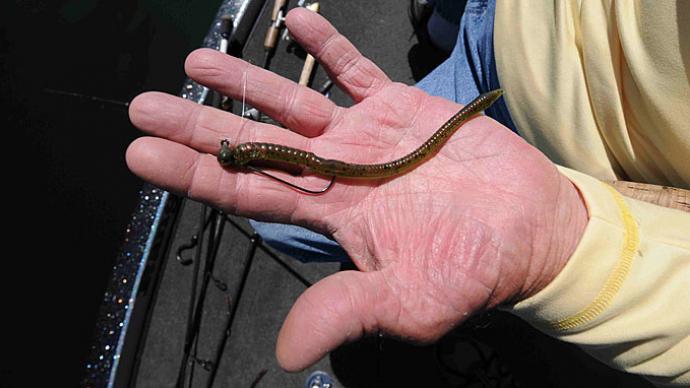
When you take a closer look at the finesse techniques, baits, and rigs bass fishermen have today, it will take both hands to count them. One specific finesse rig that is used by many bass fishermen but hardly ever talked about is the jig worm. Looking back to the finesse movement, the jig worm started this whole finesse category to take off and get noticed.
Let’s break down jig worm fishing and what it will take today to work this finesse pattern into your boat this season.
It all started back in the early ’80s in Northern Minnesota. A tackle maker had an idea that he wanted to make a jig head to fish on the fringe of weedlines. That gentleman was Connie Peterson, and his tackle company was Gopher Tackle. Connie produced a jig head shaped like a mushroom, thus being named the Mushroom Jig Head. This jig was specifically made with a light wire hook which I'll explain why in a moment. He only made the first MJH in 1/16 and 1/8oz again for a reason. In bass circles, the Mushroom jig started to take off to win tournaments through the region and soon became an Upper Midwest staple.
The whole reason behind this movement was that it was one of the first and only finesse tactics to be introduced to bass fishermen to catch neutral- to-shutoff bass. Back in the day, if the bass were shut off or buried up in the weeds, you didn't have a unique way to go in and get them out.
Yes, we had Texas rigs and rubber-legged jig to go after them, but these were big baits that the bass would see day in and day out. There were no finesse baits that you could cast to the edge of the weeds, slowly work down the edge till it got hung on a weed, snap it off, and then let free fall again until it got hung up again. That was the magic behind this early MJH worm setup, cast it up on the edge of the weeds and work the bait down the edge. Many times, you did not feel the bite. You just saw your line start to swim away.
Now that we have set the groundwork behind these early days of jig worm fishing let’s break it down further. We'll add more details to today’s setup and how to fish this finesse rig in more detail.
Jig Worm Equipment

When this tactic started to take off, spinning tackle started to change, which was also a driving force behind the finesse movement. Yes, in the early ’80s, the spinning tackle was bulky. Many of the setups were 7ft medium-action glass rods with big bulky reels that resembled today's size 300 spinning reels. But just around the corner, graphite rods were beginning to be introduced. This was a price setback initially, but it was the start of a change in the rod market and how we fished.
Making that first investment into my first graphite rod took a long time to pull the trigger, but once I did, there was no looking back as it had changed my fishing right from the first cast. I had more feel than ever before, and that was good. I could better feel what my small bait was doing as I was fishing. The reel was a steadfast spinning reel of the times - an ABU Garcia Cardinal reel - and I had a spinning setup that was in my hands day after day.
When I made a cast to the edge of the weeds, I felt what my bait was doing instead of just guessing what I thought it was doing.
In those days, monofilament was the only line choice you had. For this jig worm tactic, 8lb was the line choice of many fishermen, and if you needed to get more bites during tournament situations, you would downsize to 6lb or even 4lb in some cases.
Let’s fast-forward to today. Graphite rods are now the norm, as are affordable quality spinning reels. But today’s finesse fishing has been changed by braided line.
You can take any rod today and team this with a reel filled with braid, and you have more feel of your bait like you have never known before. The limited stretch that braid offers gives you a better feel in all fishing conditions, allowing you to use the lightest of baits today and still control what your bait is doing. This is the most significant reason finesse fishing has grown to its heights today.
Today my finesse setups consist of a 7ft medium action Denali Lithium L842DS spinning rod teamed with a Lew’s Custom Pro 2000 reel spooled with Sunline Xplasma Aesgai in 12lb test size. I'll use a Sunline Maboroshi leader in 8lb size as my first choice. I may upsize this to 10lb if I'm fishing in weedy conditions. If I'm fishing in a deep open water area, I may adjust to a 6lb leader to trigger more bites when needed.
Jig Worm Baits & Jigs

The tackle manufacturers have got behind the finesse movement and brought different baits and shapes to the bass market. A 4” Ringworm is still king in this category, and I still throw this bait as my number one choice day in and day out as I have for years running.
You also have other choices as well in today’s market. Great options include 4” Fluke baits, 4’ straight, and curly tail worms, 3” & 4” Tricksticks, and I'll add 4” lizards into this category to push the envelope in tough conditions. I consider all these staples for jig worm fishing.
When it comes to jigs, let’s break this down a little. As this presentation gathered traction, some manufacturers were trying to change the jig makeup. Today you can get mushroom jigs offered up to 1/2oz sizes, and some have changed the hooks that these jigs are made with these days. Some anglers complained that the smaller hook sizes and the light wires were costing them fish, bigger fish to be exact. And in certain conditions, I would agree as I have lost some bigger bass through the years. But upsizing the hooks didn't solve this, and in my opinion, it hurt them in other ways.
Concisely what put this jig worm presentation on the map was being able to fish this setup and get it to come off the weeds with the snap of your rod. I can't tell you how many bass I have caught by snapping my jig worm off the weeds.

With today’s braided line, that technique is more straightforward and attracts the bass. But by upsizing the jig and going to a heavier wire hook, you have taken a step backward in this process. You have made it harder to get the jig to come off the weeds with the stouter jig. Sometimes improvements take us backward instead of forward. This is a perfect example.
When getting jig heads, pay attention to the jig hook used and the size of the jig you're buying. The main three sizes that I use are 1/16oz, 1 /8oz, and 3/16oz. If I'm fishing weed presentations, I'll opt for the smaller jigs as they are easier to get to come off the weeds. I fish the 3/16oz size jig in open rock areas in deeper water when I need a little more feel.
Let me take you through the presentation. Let's start with a 1/8oz jig head rigged with a 4” Ringworm. Position your boat outside the weed edge within casting distance and make your first cast. Let the bait sink until you see slack in your line. Now pick up the lure when you get a little tension on your line. Feel to see if your line is moving. If there's no movement, reel down a little and give the rod a quick snap. This will break the jig free from the weeds and start to fall again. Pay attention to your line. If you see your line jump, set the hook, but if it goes slack again, repeat the process until you get your bait to the base of the weedline. Give it a few more moves, then reel it back in and make another cast.
The biggest reason that this presentation works so well with the tournament fishermen is that it can be fished in all conditions, windy or not because you don't keep direct contact with the bait. When fishing this presentation in windy conditions, it's fished on a slackline. You're not keeping constant tension on the bait, so you don't have to set the hook when the bait is picked up. If the bass doesn't feel you, he has no reason to spit the bait out. Does that mean that he may not feel you put tension on the line and drop the bait? No, but you will have a better chance of getting a hook into them when you fish your bait this way. This is the actual reason I feel this presentation has made me so good at hooking and catching bass during my day on the water.
Looking forward, this is the basis of today’s Ned Rig movement. The jig worm movement formed the foundation of the finesse systems used today.
Finesse fishing is here to stay with us and isn't going away. To stay in this game and catch bass all season long, there will be many days that you will have to depend on finesse tactics to get bass in your boat. Day in and day out, this is the one finesse tactic that I always turn to when I need to put bass in the boat.
BassResource may receive a portion of revenues if you purchase using a link above.




